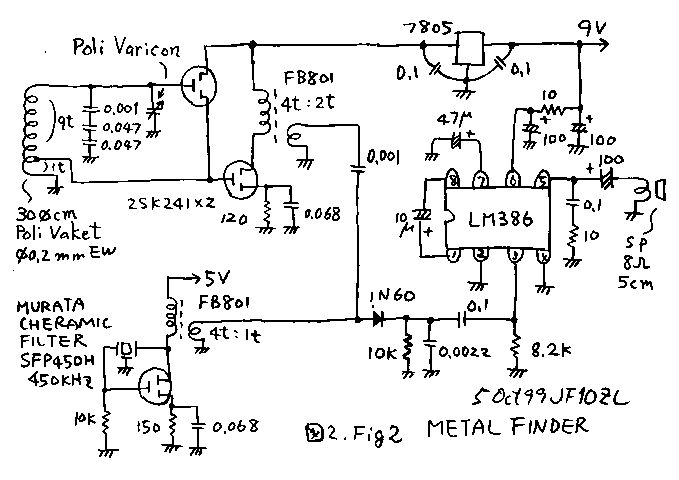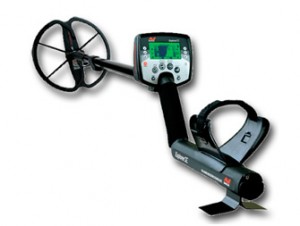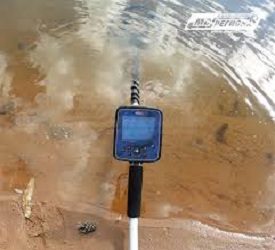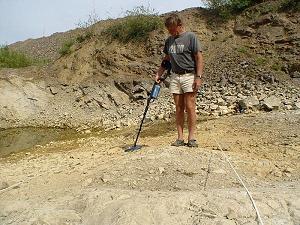The principles of operation of metal detectors
metal detectors operating principles
What is a metal detector, and how he manages to distinguish metals ? Metal detector – an electronic device that detects the presence of metal without contact with it ( thanks to exposure to radio waves and the capture of secondary signals) , and, if found , notify the fact of the operator ( snooze, moving arrows , etc.).
When the device is in the search head creates an electromagnetic field which extends into the environment , whether land , stone, water, wood , and air. On the surface of metal caught in the zone of the search coil by electromagnetic fields arise so-called eddy currents . These eddy currents produce their own opposing electromagnetic fields, leading to reduction of power of the electromagnetic field generated by the coil , which is fixed and the electronic circuit device . Moreover, this secondary field distorts the primary field configuration , which is also detected by the instrument. Electronic circuit metal detector processes the information and signals detection of metal. Eddy currents are formed on the surface of any metallic objects or conductive minerals. Metals such as gold, silver, copper has a high electrical conductivity compared with iron, a thin aluminum foil , nickel and minerals. Determination of the metal in the object based on the measured conductivity of the object.
The difference between cheap and expensive models is only in the methods of radio wave radiation and methods of collecting and processing and interpretation of secondary signals . The more expensive the device can determine with some degree of probability view of the detected metal to extract it , determine its depth , can build up minerals from the soil , and have a lot of different additional features that enhance the performance and efficiency of search results that are absent in the cheap devices.
The literature distinguishes between the following basic approaches to the construction of metal circuitry :
1 ) BFO – beat frequency oscillation ( the beat method ) . The measured parameter is the frequency of the LC- oscillator comprising a coil search head . Frequency is compared with the reference and the resulting difference frequency is displayed on the beats sound indication . Circuitry devices is fairly simple , the coil does not require precise execution. Operating frequency 40 – 500 kHz. BFO- sensitivity devices at low low stability and low possibilities to build up from the wet and the mineralized pound. BFO method used in mass-produced foreign instruments in 60-70 years. Currently, this method is popular among amateurs and inexpensive devices found in Russian manufacturers.
2 ) TR / VLF – trabsmitter-reciver / very low frequency ( transmitter and receiver is very low frequency). Search coil form two coils arranged in a single plane and balanced so that when a signal is applied to the transmitting coil is present at the outputs of the minimum reception signal. The transmitter coil is included in the LC- circuit generator. The measured parameter is the amplitude of the signal at the receiving coil and the phase shift between the transmitted and the received sinusoidal signals . VLF – variation of this method , when the operating frequency is reduced to 1 – 10 kHz -20 kHz at normal .
VLF – the method allows to build highly sensitive instruments with good discrimination of metals by analyzing the phase characteristics . Circuit design is quite complex devices , coils require precision balancing. By this method constructed now most serial devices , including computerized . Discrimination of objects and ground balancing in such devices is relatively simple with the help of phase-shifting circuits.

metal detectors operating principles
The principle of TR ( or its variant TR / VLF) provides an analysis of the phase characteristics of the signal , so they are all easy to distinguish ferrous and non-ferrous metals, rebuilt from the debris and soil. These devices have a high sensitivity and resolution, which depends on the diameter of the head – head greater than the deeper detection, but more difficult to seek small objects.
3 ) RF – radio frequency – high TC embodiment where the transmitting and receiving coils do not form a flat transformer, and separated in space and arranged perpendicular to each other. The receiving coil receives a reflected signal from the metal surface , the emitted transmitting coil . Operating frequency range 70 – 500 kHz . This method is used in the interior devices and is characterized by insensitivity to small objects and the lack of discernment metals.
4 ) PI – pulse induction . In devices of this type of reel search head is not part of the oscillation circuit . It is supplied by the trigger pulse generator signal. Analyzed parameter is the time of completion of the transition process (the position of the trailing edge of the pulse voltage ) . By the design of the coil are not any special requirements. The distinctive features of this method are: low operating frequency of the pulse (50 – 400 Hz), high energy consumption, insensitivity to the ground , not very good recognition of metals , instruments do not require periodic adjustments. PI- method is often used in submarine devices to reduce the influence of water .
5 ) OR – off resonance ( resonance breakdown ) . Analyzed parameter is the signal amplitude at the coil oscillating circuit tuned close to resonance with the signal applied thereto from the generator. The appearance of metal in the coil causes a resonance or reaching or leaving from it, depending on the type of metal, which leads to an increase or decrease in amplitude in the coil. This method as well as the BFO was developed by radio amateurs , but no information about its use in serial devices to search for treasures were found.
As the complexity of design of the device and increase its value improves the ability of the device to recognize a metal object without digging . If the difference is several times the cost of the detector sensitivity increases slightly (usually it is 20 – 35 cm for coins and about 1 – 1.5 m for large finds) . However, more complex devices equipped with processors that can give an opinion not only on the composition of the metal and the depth of discovery , but also to determine the value of the coin .
In the most common form of metal detectors can be divided into the following groups :
purpose – to find small objects ( coins , jewelry, nuggets ) to a depth of 40 cm in the soil and large ( the size of a teapot and more) to a depth of 1 – 1.5 m usually are devices that operate on the principle of ” transmitter receiver ” inductively balance. The transmitting and receiving coils are located in the same plane and form a search head. Head diameter of 10-40 cm (the way – 21 cm).
deep – to search only for large objects at a depth of 2 – 6 mm devices use the principle of the CD and coils are located at a great distance from each other ( 50 – 100 cm) in the perpendicular planes. For these purposes and Switching Devices diameter coil meter or more . These devices look good chests, boxes, lost equipment and the like, but they are not sensitive to the coins and other small items and do not distinguish between metals .
underwater – sealed devices with a specific indication for searching underwater diving. In the majority of these devices use a pulse induction principle , which significantly reduces the influence of water as a conductive medium to search . Depth pulse detection device ( not only underwater ) are usually longer than TR / VLF. These devices do not require manual tuning but have difficulty in distinguishing between metals.
prospectors – search for preferred individual objects made of precious metals ( native gold , silver). Usually this TR / VLF apparatus for searching gold optimized for searching small nuggets that requires a different operating frequency than the universal device .
construction – to search for pipes, cables and other underground utilities . This may also include magnetometers to find iron. Their principle of operation is somewhat different from the induction metal detectors.
security devices can be divided into wearable devices Inspection , stationary detectors : the so-called . “Walk through metal detectors ” .
Keywords
metal detectors ,metal detector ,whites metal detectors ,garrett metal detectors ,metal detector reviews ,best metal detector ,bounty hunter metal detector ,metal detectors for sale ,white metal detectors ,fisher metal detectors ,tesoro metal detectors ,kellyco metal detectors ,metal detecting , detectors for gold ,xp metal detectors
metal detectors operating principles
- Hidden camera detector for security work
- garrett 2500 metal detector manual
- gold finder pro metal detectors
- Outdoor Surveillance Camera
- What is a dowser?
- What are the metal detectors
- Bug detectors
- Minelab SDC 2300 metal detector
- Search for gold with a metal detector the best metal detectors for gold
- industrial metal detectors for food













